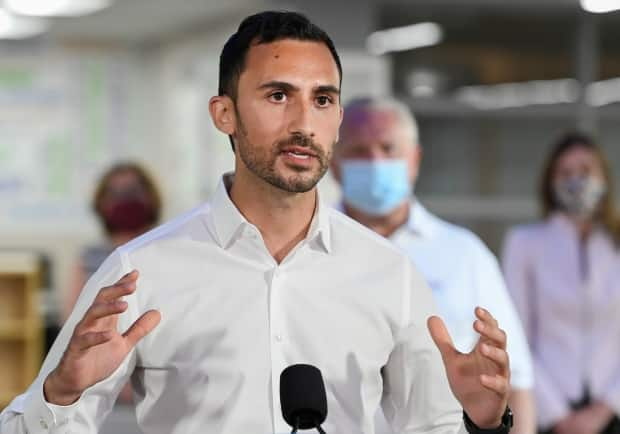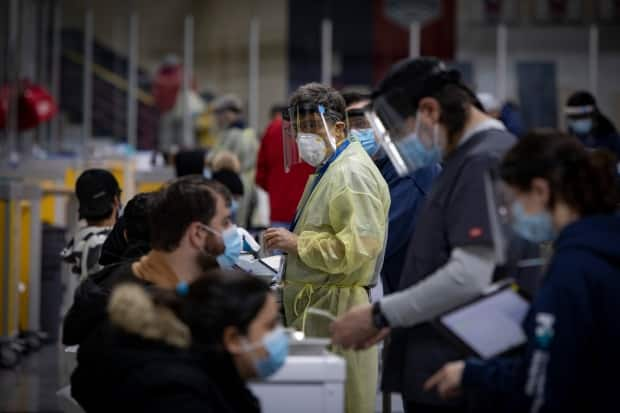Ontario to offer remote learning next school year, but no details on return to class this spring

Ontario will offer online learning for the next school year, Education Minister Stephen Lecce said Tuesday, though he offered no news about whether or not students might return to in-person classes this spring.
At a news conference Tuesday, reporters asked the minister a variety of questions about the current school year, but Lecce repeatedly deferred to the advice of Medical Officer of Health Dr. David Williams, who was not present.
"When we get updated advice ... you will know it," Lecce said.
The education minister did say the province wants kids to be back in school, and will continue to seek advice from the Williams "on the way forward.
"We will not take risks with your child," he said.
The province says the option to use online learning will be available for the entire 2021-2022 school year and it will be providing more information to parents in the coming months.
The government also says it will increase funding to school boards by $561 million next year to help address continued pandemic-related costs.
It says it will spend a total of $25.6 billion on the education system in 2021-2022 — an increase of 2.2 per cent over the previous year.
The province says it will allow boards to access their reserves, as it did last year, to help address pandemic costs.
It will also extend $1.6 billion in COVID-19 supports to boards, including millions to upgrade ventilation, support learning recovery, and allow for flexible staffing.
The government says it will also continue funding for the purchase of personal protective equipment, COVID-19 testing and replacement of devices.

It cautions, however, that boards should only budget for half of those resources during the first half of the year, and that the remaining funding depends on vaccine distribution and public health advice.
All schools are currently teaching students online as Ontario remains under a stay-at-home order.
Kelly Gallagher-Mackay, an assistant professor at Wilfred Laurier University who studies educational inequality, told CBC News she was unimpressed by Tuesday's announcement, calling it a "business-as-usual budget in the middle of an enormous crisis and huge educational disruption.
"It's really surprising that they put so little money into providing supports to help students and the education system recover from a year of incredible disruption and … hardship for many students," she said.
Most surprising, Gallagher-Mackay said, was the $20 million the province is earmarking for learning recovery, which she says is crucial and is being funded at higher rates in the United Kingdom and United States.
"We're talking peanuts. That's $10 a student for learning recovery in Ontario, and that's really not going to close any gaps," she said.
Case count drops below 3,000
Meanwhile, Ontario reported another 2,791 cases of COVID-19 and the deaths of 25 more people with the illness on Tuesday.
The last time the daily case count was below 3,000 in the province was nearly a month ago on April 5. It's also the fewest new infections reported on a single day since April 1.
Notably, though, Tuesdays frequently see the lowest numbers of new cases relative to other days of the week, likely due to the processing of weekend tests on Mondays.
Today's count comes as labs completed just 33,740 tests and Public Health Ontario logged a provincewide positivity rate of 9.1 per cent. Officials said Monday that the seven-day average test positivity rate was 8.3 per cent.
Last Tuesday there were 3,265 further cases confirmed with about the same number of processed tests and a per cent positivity rate of 10.2.
It could be an indicator that the growth in infections is continuing its recent trend of slowing, but firm conclusions can't be drawn from any one day of data.It is also possible that the relatively low overall testing figures of recent weeks and high positivity rates mean that infections are going unconfirmed.
The additional cases reported today include:
931 in Toronto
653 in Peel Region
275 in York Region
147 in Durham Region
128 in Hamilton
112 in Ottawa
101 in Halton Region
The seven-day average fell to 3,509, its lowest point in more than three weeks. The indicator has been steadily falling since its pandemic-high of 4,370 on April 17.
More Pfizer vaccines set to arrive this week
Another 3,323 cases were marked resolved in today's provincial update. There are about 36,440 confirmed, active infections throughout Ontario.
As of yesterday, there were 2,167 people with COVID-19-related illnesses in hospitals, 886 of whom were being treated in intensive care units, according to the Ministry of Health. Of those, 609 required ventilators to breathe.

Critical Care Services Ontario, an agency that puts together internal reports for hospitals and health organizations, said that 64 more patients were sent to ICUs yesterday. New daily admissions to critical care have remained high, with patients spending on average 11.4 days in ICUs.
The 25 further COVID-linked deaths push Ontario's official toll to 8,143. The seven-day average of daily deaths dropped slightly to 25.6, from 26.1
Public health units collectively administered 88,871 doses of COVID-19 vaccines Monday, the province said. Some 378,085 people have gotten both shots of a vaccine.
Ontario has given out 5,467,120, or nearly 97 per cent, of the 5,644,975 doses it has received to date. A shipment of 786,240 more shots of the Pfizer-BioNTech vaccine is scheduled to arrive this week.
Ford continues to push about borders
Also Tuesday, Premier Doug Ford issued another statement calling on the federal to impose further border restrictions.
That's despite the most recent data from Public Health Ontario saying about 1.6 per cent of Ontario's 476,692 total cases of COVID-19 have confirmed links to travel. Outbreaks and close contacts account for about 60 per cent.
Ford said his government wants a ban on all non-essential travel, pre-departure COVID-19 tests for domestic flights and for Ottawa to close a loophole that allows some travellers to cross a land border without having to quarantine. The province has sent three "urgent letters" in the last weeks without a formal response from Prime Minister Justin Trudeau, the statement said.
"More can and must be done. We cannot sit back and watch the fourth wave of COVID-19 walk across our border," the statement said.
The Ontario Progressive Conservatives are now buying Facebook ads in an effort to get people to sign a petition to ban all non-essential travel to Canada. The federal government banned non-residents from non-essential travel last March, but some people are still circumventing border measures that have been put in place in recent months.
Variants of concern have been circulating in the province since at least early this year. The COVID-19 science advisory table warned about the potential for explosive case growth due to new variants in late January and again in mid-February.
Briefings from the independent group of experts cautioned against reopening public health units too early after the second wave of the pandemic eased.

